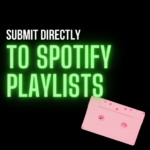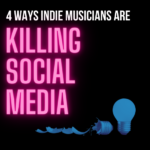Houston we have a problem! it’s Fake Spotify Playlists Playlists. When you think of streaming music, where is the first place your mind goes? Spotify of course. For most artists, it’s also what you think of when it comes time to consider pitching playlists for your music. It’s true; there’s no denying that Spotify has revolutionized the way we listen to music, offering an extensive library of songs and playlists in just about every genre or mood we could ever imagine (and even those we can’t!) The other problem is – Fake Spotify Playlists Playlists.
While Spotify is a haven for discovering new music, it’s also a breeding ground for fake Spotify playlists, which I don’t have to tell you can seriously harm indie artists. Not only can fake plays lead to Spotify deleting your song from their platform but it also makes it next to impossible to truly grow your fanbase since fake playlists are made of bots (not real people) playing your song. That means no real people listening, and essentially watering down your listener base.
In this guide, we’ll show you how to spot a fake Spotify playlist and protect your musical journey.
Verify the Playlist Creator
One of the first things to check when trying to identify a fake Spotify playlist is the creator’s profile. Legitimate playlists often belong to reputable users or curators with established profiles. Look at the obvious: do they have a user profile, is their username legitimate looking or is it all numbers and letters, and so on.
Be cautious if the playlist creator has a blank or unverified profile, or if their username appears suspicious. Established curators often have a dedicated following and are more likely to curate high-quality playlists. Like most things, quantity over quality is important.
Check the Title and Description
Pay close attention to the playlist’s title and description. Like a suspicious username or lack of profile photo, these are usually easy to spot. Fake playlists may use sensational or misleading titles or fake collaborations to attract users. If the playlist title promises “exclusive” or “unreleased” content from famous artists, you should almost certainly assume it’s fake. Authentic playlists generally have straightforward, descriptive titles and informative descriptions and the songs usually make sense. Likewise, quality playlists will often be highly curated—meaning it won’t be 10,000 songs per playlist.
Pay Attention To The Songs On the Playlist
Going off what we were just talking about, spend a minute scanning the playlist to get a sense of what’s on there. Fake playlists often contain low-quality or unrelated songs. For example, a hip-hop song, a country song, and a pop song all together. That doesn’t make a lot of sense, especially if the playlist is called something like “Cowboy Bops” right?
You’re looking to make sure the playlist is cohesive within a certain theme, genre, or feel. Authentic playlists generally feature songs that fit the playlist’s overall mood and genre.
You can even take it a step further and click on one of the songs in the playlist to see where the listeners come from and how well-known the artist is vs the plays they’re receiving. This will give you an idea of the legitimacy of the playlist as well.
Investigate the Number of Followers and History
There are lots of neat tools that allow you to check spikes in follower count like Chartmetric. It will help you determine if a playlist is authentic or not. If there are massive spikes and drops in the playlist, that can be an indicator of a fake playlist. However, if there’s steady growth and the above things (cohesive playlist, album art, and titles that make sense, etc.) are all in line, then you might have an authentic playlist on hand.
Go with your gut
I know, I know, this might seem like silly advice but odds are you’ll know a fake playlist when you spot one. While some of these playlists are a bit more sophisticated and might be easier to spot, most will have the same characteristics. That is:
Spammy titles with spammy characteristics such as excessive keywords, emoji, or links in the title or description (used to leverage Spotify’s algorithm and gain visibility), they’ll have genres together that don’t make sense, spikes and falls in follower counts, cover art that seems unrelated or generic to the playlist, and/or suspicious profiles.
Final thoughts
By following these tips, you can become more adept at spotting fake Spotify playlists and focus on landing on the ones that are not only authentic but poised to get you actual, real fans. Remember to trust your instincts and stay cautious when exploring new playlists. Happy playlisting!
Want marketing tips? Download our Music Marketing Checksheet to learn the strategies, hacks, and platforms we use daily right here at Cyber PR to execute multiple successful music marketing campaigns for independent artists just like you every day.












